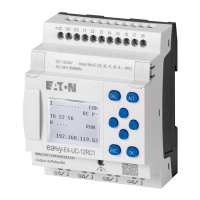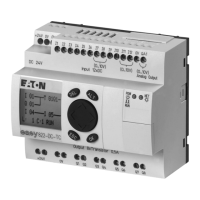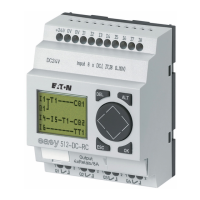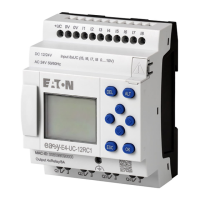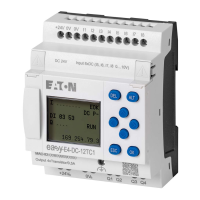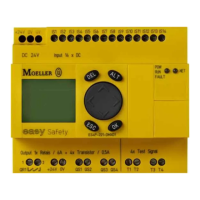4 Wiring with
4.6 High-speed counters, -DA, -DC
Operating instructions 05/10 MN05013003Z-EN www.eaton.com 107
Example: counting measuring pulses and setting an output
Measuring pulses can represent lengths, rotations, angles or other values.
These program sections are required for applications involving the filling of
sacks, bags or the cutting of foil.
The count signals are continuously present at I1. The high-speed counter C13
counts these pulses. The counter is automatically set to zero if the actual
value equals the setpoint. Contact C13 is then set for one program cycle. The
output Q3 is set at the same time. This is then reset by input I8.
Example: running motors or spindles in parallel.
Applications may involve motion control with the parallel control of two
drives. Only certain deviations are permissible so that the mechanical system
does not jam.
These tasks can be implemented with the following solution.
I8 starts the drives. I7 and I6 carry the feedback signals of the motor
protective circuit breakers. The drives are stopped if a motor protective
circuit breaker trips. The analog value comparators control the difference of
the path distance. The appropriate drive is stopped temporarily if one path
distance is outside of the set tolerance. The following applies:
• M8 = enable for all drives.
• Q1 = drive 1, counter drive 1 is connected with input I1 and this with
high-speed counter C13.
• Q2 = drive 2, counter drive 2 is connected with input I2 and this with
high-speed counter C14.
• A1 = comparison, if C13 is less than C14, drive 2 is too fast.
• A1 = comparison, if C13 is less than C14, drive 2 is too fast.
• A3 = comparison, if C13 and C14 are equal, both drives can be activated.
• The hysteresis value of A1, A2 and A3 depends on the resolution of the
transducer and the mechanical system.
Circuit diagram display Parameter settings of the
counter C13
N1------CC13
C13-----SQ13
C13 -----RC13
I8------RQ13
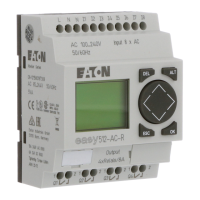
